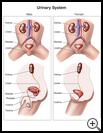
CT Urogram
________________________________________________________________________
KEY POINTS
- A CT urogram is a type of X-ray test that uses contrast dye to create detailed pictures of the kidneys, ureters, bladder, and urethra.
- You may have this test to check for causes of blood in your urine, to check for a blockage in the kidneys or ureters, or to check whether urinary tract cancer treatments are working.
- Ask your healthcare provider how and when you will get your test results, what problems you should watch for, and what to do if you have them.
________________________________________________________________________
What is a CT urogram?
A CT urogram, also called computed tomography (CT) urogram, is a type of X-ray test. X-rays are taken from different angles after contrast dye is injected into a vein. A computer puts the X-rays together to create detailed pictures of the urinary tract. The urinary tract includes:
- Kidneys, which make urine
- Ureters, which are the tubes that carry urine from the kidneys to the bladder
- Bladder, which stores urine
- Urethra, which is the tube that drains urine from the bladder and out of the body
When is it used?
This test may be done to:
- Check for causes of blood in your urine such as tumors, kidney stones, or bladder stones
- See how well some urinary tract cancer treatments are working
- Check for problems in your urinary tract if you have had an injury to your back or belly area
- Check for a blockage in the kidneys or ureters
How do I prepare for this procedure?
- Plan for your care and a ride home after the procedure.
- Tell your healthcare provider about all medicines and supplements that you take. Some products may increase your risk of side effects. Ask your healthcare provider if you need to avoid taking any medicine or supplements before the procedure.
- Tell your healthcare provider if you have any food, medicine, or other allergies such as latex.
- Tell your healthcare provider and the CT technician if you may be pregnant.
- Your healthcare provider will tell you when you need to stop eating and drinking before the procedure. This helps to keep you from vomiting during the procedure.
- You may be asked to drink water and to avoid urinating before the procedure. This helps fill the bladder to allow better quality X-rays.
- Your healthcare provider may give you medicine to help you relax before the scan.
- Follow any other instructions your healthcare provider gives you.
- Ask any questions you have before the procedure. You should understand what your healthcare provider is going to do. You have the right to make decisions about your healthcare and to give permission for any tests or procedures.
What happens during the procedure?
You will need to wear a hospital gown so that zippers on clothing or other items do not interfere with the X-ray picture.
Your healthcare provider or technician will inject contrast dye into a vein in your arm. The contrast dye moves through your kidneys to your urinary tract and into your urine. It makes the parts of the urinary tract show up on the scan.
You will lie down on a moving table that will slide into the scanner. The CT scanner is a large machine with a tunnel in the center. Inside the scanner, many X-ray beams pass very quickly through your body at different angles. You will need to stay still during the scan so that the pictures will not be blurry. Images of your urinary tract will show on a computer screen and will be prepared for your healthcare provider to examine later.
Some people get anxious because of the small, enclosed space. If you start feeling panicky or are having other problems, the scan may be stopped. Your healthcare provider may give you medicine to help you relax during the scan.
What happens after the procedure?
Usually, you can go home soon after the test. If you received medicine to help you relax, you will be watched carefully until you are fully awake and alert. This may take from 15 minutes to 2 hours.
If you were given contrast dye for the scan, drink lots of liquids after the scan to help your body get rid of the contrast dye. If you are breast-feeding a baby, ask your healthcare provider how long you should wait before you can resume breast-feeding.
Ask your healthcare provider:
- How and when you will get your test results
- What symptoms or problems you should watch for and what to do if you have them
Make sure you know when you should come back for a checkup. Keep all appointments for provider visits or tests.
What are the risks of this procedure?
Every procedure or treatment has risks. Some possible risks of this scan include:
- The radiation you get from a CT scan may cause a small increase in your lifetime risk of developing cancer.
- In rare cases, you may have an allergic reaction to medicines used during the procedure.
- If you are pregnant, there is a risk the X-rays will hurt the baby.
Ask your healthcare provider how these risks apply to you. Be sure to discuss any other questions or concerns that you may have.

